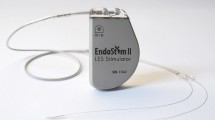Abstract
Background
The components of esophageal function important to success with laparoscopic adjustable gastric banding (LAGB) are not well understood. A pattern of delayed, however, successful bolus transit across the LAGB is observed.
Methods
Successful LAGB patients underwent a high-resolution video manometry study in which bolus clearance, flow, and intraluminal pressures were recorded. Liquid and semi-solid swallows and stress barium (a combination of semi-solid swallows and liquid barium) were performed. A new measurement, the lower esophageal contractile segment (LECS), was defined and evaluated.
Results
Twenty patients participated (mean age 48.3 ± 12.0 years, four men, %excess weight loss 65.6 ± 18.0). During semi-solid swallows, two patterns of esophageal clearance were observed: firstly, a native pattern (n = 10) similar to that which is expected in non-LAGB patients; secondly, a lower esophageal sphincter-dependent pattern (n = 7), where flow only occurred when the intrabolus pressure increased during the lower esophageal sphincter (LES) aftercontraction. In both patterns, if there was incomplete bolus clearance, reflux was observed and was usually followed by another swallow. A mean of 4.5 ± 2.9 contractions were required to clear the semi-solid bolus. Contractions with an intact LECS demonstrated longer flow duration: 7.1 ± 3.8 vs.1.6 ± 3.2 s, p < 0.005. During the stress barium, an intrabolus pressure of 44.5 ± 16.0 mm Hg leads to cessation of intake.
Conclusions
In LAGB patients, normal esophageal peristaltic contractions transition to a LES aftercontraction, producing trans-LAGB flow. Repeated contractions are required to clear a semi-solid bolus. Incorporating measurements of the LECS into assessments of esophageal motility in LAGB patients may improve the usefulness of this investigation.




Similar content being viewed by others
References
Favretti F, Ashton D, Busetto L, et al. The gastric band: First-choice procedure for obesity surgery. World J Surg 2009;10:2039–48.
O’Brien PE, Dixon JB, Brown W. Obesity is a surgical disease: overview of obesity and bariatric surgery. ANZ J Surg. 2004;74:200–4.
O’Brien PEPE, Dixon JBJB. Lap-band: outcomes and results. J Laparoendosc Adv Surg Tech. 2003;13:265–70.
de Jong JR, Besselink MG, van Ramshorst B, et al. Effects of adjustable gastric banding on gastroesophageal reflux and esophageal motility: a systematic review. Obes Rev 2009;Jun 26. [Epub ahead of print].
Burton PR, Brown WA, Laurie C, et al. The effect of laparoscopic adjustable gastric bands on esophageal motility and the gastroesophageal junction; analysis using high resolution video manometry. Obes Surg. 2009;19:905–14.
Burton PR, Brown WA, Laurie C, et al. Pathophysiology of laparoscopic adjustable gastric bands: Analysis and classification using high resolution video manometry and a stress barium protocol. Obes Surg 2009;Sep 18. [Epub ahead of print].
Goyal RK, Chaudhury A. Physiology of normal esophageal motility. J Clin Gastroenterol. 2008;42:610–9.
Ghosh SK, Kahrilas PJ, Lodhia N, et al. Utilizing intraluminal pressure differences to predict esophageal bolus flow dynamics. Am J Physiol Gastrointest Liver Physiol. 2007;293:G1023–8.
Pandolfino JE, Ghosh SK, Lodhia N, et al. Utilizing intraluminal pressure gradients to predict esophageal clearance: a validation study. Am J Gastroenterol. 2008;103:1898–905.
Tutuian R, Castell DO. Combined multichannel intraluminal impedance and manometry clarifies esophageal function abnormalities: study in 350 patients. Am J Gastroenterol. 2004;99:1011–9.
Kahrilas PJ, Dodds WJ, Hogan WJ. Effect of peristaltic dysfunction on esophageal volume clearance. Gastroenterology. 1988;94:73–80.
Kahrilas PJ, Ghosh SK, Pandolfino JE. Esophageal motility disorders in terms of pressure topography: the Chicago Classification. J Clin Gastroenterol. 2008;42:627–35.
Fox MR, Bredenoord AJ. Oesophageal high-resolution manometry: moving from research into clinical practice. Gut. 2008;57:405–23.
Burton PR, Brown WA, Laurie CP, et al. Effects of gastric band adjustments on intraluminal pressure. Obes Surg 2009; in press.
Muinuddin A, Xue S, Diamant NE. Regional differences in the response of feline esophageal smooth muscle to stretch and cholinergic stimulation. Am J Physiol Gastrointest Liver Physiol. 2001;281:G1460–7.
Cohen S, Green F. The mechanics of esophageal muscle contraction. Evidence of an inotropic effect of gastrin. J Clin Invest. 1973;52:2029–40.
Tottrup A, Forman A, Uldbjerg N, et al. Mechanical properties of isolated human esophageal smooth muscle. Am J Physiol. 1990;258:G338–43.
Clouse RE, Staiano A. Topography of normal and high-amplitude esophageal peristalsis. Am J Physiol. 1993;265:G1098–107.
Pouderoux P, Shi G, Tatum RP, et al. Esophageal solid bolus transit: studies using concurrent videofluoroscopy and manometry. Am J Gastroenterol. 1999;94:1457–63.
Patel RS, Rao SS. Biomechanical and sensory parameters of the human esophagus at four levels. Am J Physiol. 1998;275:G187–91.
Holloway RH. Esophageal body motor response to reflux events: secondary peristalsis. Am J Med. 2000;108(Suppl 4a):20S–6.
Licht H, Fisher RS. Downstream effects of esophageal distention. Curr Gastroenterol Rep. 2006;8:186–9.
Brown W, Burton P, Anderson M, et al. Symmetrical pouch dilatation after laparoscopic adjustable gastric banding: incidence and management. Obes Surg. 2008;18:1104–8.
Author information
Authors and Affiliations
Corresponding author
Rights and permissions
About this article
Cite this article
Burton, P.R., Brown, W.A., Laurie, C. et al. Mechanisms of Bolus Clearance in Patients with Laparoscopic Adjustable Gastric Bands. OBES SURG 20, 1265–1272 (2010). https://doi.org/10.1007/s11695-009-0063-9
Received:
Accepted:
Published:
Issue Date:
DOI: https://doi.org/10.1007/s11695-009-0063-9




